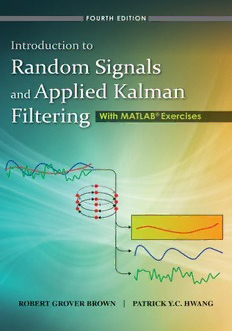Table Of ContentFFIRS 12/14/2011 9:6:46 Page2
FFIRS 12/14/2011 9:6:46 Page1
FOURTH EDITION
Introduction to
Random Signals
and Applied Kalman
Filtering
WITH MATLAB EXERCISES
FFIRS 12/14/2011 9:6:46 Page2
FFIRS 12/14/2011 9:6:46 Page3
FOURTH EDITION
Introduction to
Random Signals
and Applied Kalman
Filtering
WITH MATLAB EXERCISES
Robert Grover Brown
ProfessorEmeritus
IowaStateUniversity
Patrick Y. C. Hwang
RockwellCollins,Inc.
John Wiley & Sons, Inc.
FFIRS 12/14/2011 9:6:46 Page4
VPandPublisher DonFowley
AssociatePublisher DanSayre
EditorialAssistant CharlotteCerf
SeniorMarketingManager ChristopherRuel
SeniorProductionManager JanisSoo
SeniorProductionEditor JoycePoh
Designer JamesO’Shea
Thisbookwassetin10/13PhotinaRegularbyThomsonDigital.PrintedandboundbyCourierWestford.
ThecoverwasprintedbyCourierWestford.
Thisbookisprintedonacidfreepaper.
Foundedin1807,JohnWiley&Sons,Inc.hasbeenavaluedsourceofknowledgeandunderstandingfor
morethan200years,helpingpeoplearoundtheworldmeettheirneedsandfulfilltheiraspirations.Our
companyisbuiltonafoundationofprinciplesthatincluderesponsibilitytothecommunitiesweserveand
whereweliveandwork.In2008,welaunchedaCorporateCitizenshipInitiative,aglobalefforttoaddressthe
environmental,social,economic,andethicalchallengeswefaceinourbusiness.Amongtheissuesweare
addressingarecarbonimpact,paperspecificationsandprocurement,ethicalconductwithinourbusinessand
amongourvendors,andcommunityandcharitablesupport.Formoreinformation,pleasevisitourwebsite:
www.wiley.com/go/citizenship.
Copyright#2012,1997,1992,1983JohnWiley&Sons,Inc.Allrightsreserved.Nopartofthispublication
maybereproduced,storedinaretrievalsystemortransmittedinanyformorbyanymeans,electronic,
mechanical,photocopying,recording,scanningorotherwise,exceptaspermittedunderSections107or108
ofthe1976UnitedStatesCopyrightAct,withouteitherthepriorwrittenpermissionofthePublisher,or
authorizationthroughpaymentoftheappropriateper-copyfeetotheCopyrightClearanceCenter,Inc.222
RosewoodDrive,Danvers,MA01923,websitewww.copyright.com.RequeststothePublisherforpermission
shouldbeaddressedtothePermissionsDepartment,JohnWiley&Sons,Inc.,111RiverStreet,Hoboken,
NJ 07030-5774, (201)748-6011, fax (201)748-6008, website http://www.wiley.com/go/permissions.
Evaluationcopiesareprovidedtoqualifiedacademicsandprofessionalsforreviewpurposesonly,forusein
theircoursesduringthenextacademicyear.Thesecopiesarelicensedandmaynotbesoldortransferred
toathirdparty.Uponcompletionofthereviewperiod,pleasereturntheevaluationcopytoWiley.Return
instructions and a free of charge return shipping label are available at www.wiley.com/go/returnlabel.
OutsideoftheUnitedStates,pleasecontactyourlocalrepresentative.
LibraryofCongressCataloging-in-PublicationData
Brown,RobertGrover.
IntroductiontorandomsignalsandappliedKalmanfiltering:withMATLABexercises/RobertGrover
Brown,PatrickY.C.Hwang.—4thed.
p.cm.
Includesindex.
ISBN978-0-470-60969-9(hardback)
1. Signalprocessing—Dataprocessing. 2. Randomnoisetheory. 3. Kalmanfiltering—Data
processing. 4. MATLAB. I. Hwang,PatrickY.C. II. Title.
TK5102.9.B752012
0
621.3822—dc23 2011042847
PrintedintheUnitedStatesofAmerica
10 9 8 7 6 5 4 3 2 1
FPREF 12/14/2011 9:10:39 Page5
Preface To The Fourth Edition
We are happy to report that Kalman filtering is alive and well after 50 years of
existence. New applications keep appearing regularly which broadens the interest
throughoutengineering.This,ofcourse,hasallbeenmadepossiblebythefantastic
advancesincomputertechnologyoverthepastfewdecades.Ifitwerenotforthat,
the neat recursive solution for the Wiener filter problem that R. E. Kalman
introducedin1960wouldprobablyonlyberememberedasaninterestingacademic
curiosity,inengineeringliteratureatleast.Enoughofthehistory;clearly,Kalman
filteringisheretostay.Itiseminentlypractical,andithaswithstoodthetestoftime.
ThistextisarevisionoftheThirdEditionofIntroductiontoRandomSignals
andAppliedKalmanFilteringwithMATLABExercises.Kalmanfilteringhasnow
reachedastageofmaturitywhereavarietyofextensionsandvariationsonthebasic
theory have been introduced since the Third Edition was published in 1997. We
haveincludedsomeofthesedevelopments,especiallythosethatdealwithnonlinear
systems.TheextendedKalmanfilterisincludedbecauseitisusedwidelyanditis
still the preferred solution to many integrated navigation systems today, just as it
was a few decades ago.
Ourintentisstilltokeepthebookattheintroductorylevelwithemphasison
applications. We feel that this material is suitable for undergraduate as well as
beginninggraduatecourses.Thenecessaryprerequisitematerialforthisbookwill
befoundinanumberofbooksonlinearsystemsanalysisorlinearcontrolsystems.
Wethinkthatwehaveimprovedtheorganizationofthetextmaterialinthisedition
bymakingadistinctseparationoftherandomsignalsbackgroundmaterial(Part1)
andthemainsubjectofappliedKalmanfiltering(Part2).Studentswhohavealready
hadacourseinrandomprocessesandresponseoflinearsystemstorandominputs
may want to move directly to Part 2 and simply use Part 1 as reference material.
Part1(Chapters1through3)includestheessentialnotionsofprobability,an
introduction to random signals and response to linear systems, state-space model-
ing, and Monte Carlo simulation. We have found from teaching both university-
creditandcontinuing-educationcoursesthatthemainimpedimenttolearningabout
Kalman filtering is not the mathematics. Rather, it is the background material in
randomprocessesthatusuallycausesthedifficulty.Thus,thebackgroundmaterial
in Part 1 is most important.
v
FPREF 12/14/2011 9:10:39 Page6
vi PREFACETOTHEFOURTHEDITION
Part 2 (Chapters 4 through 9) contains the main theme of the book, namely
appliedKalmanfiltering.Thispartbeginswiththebasicfilterderivationusingthe
minimum-mean-square-errorapproach.Thisisfollowedbyvariousembellishments
onthebasictheorysuchastheinformationfilter,suboptimalanalysis,conditional
density viewpoint, Bayesian estimation, relationship to least squares and other
estimators,smoothing,andothermethodsofcopingwithnonlinearities.Chapter8
isacompletelynewchapterthatexpandsonthecomplementaryfiltermaterialinthe
Third Edition. Chapter 9 deals entirely with applications, mainly those in the
engineering field of positioning, navigation, and timing (PNT).
The authors wish to thank all of our former students and colleagues for their
manyhelpfulcommentsandsuggestionsovertheyears.Specialthanksgoestothe
late Larry Levy. His generous counsel and advice on many aspects of Kalman
filtering will certainly be missed.
RobertGroverBrown
Patrick Y. C. Hwang
FTOC 12/14/2011 9:44:19 Page7
Brief Contents
Preface v
PART 1 RANDOM SIGNALS BACKGROUND 1
1
ProbabilityandRandomVariables:AReview 3
2
MathematicalDescriptionofRandomSignals 57
3
LinearSystemsResponse,State-SpaceModeling,and
MonteCarloSimulation 105
PART 2 KALMAN FILTERING AND APPLICATIONS 139
4
DiscreteKalmanFilterBasics 141
5
IntermediateTopicsonKalmanFiltering 173
6
SmoothingandFurtherIntermediateTopics 207
7
Linearization,NonlinearFiltering,andSampling
BayesianFilters 249
8
The“Go-Free”Concept,ComplementaryFilter,and
AidedInertialExamples 284
vii
FTOC 12/14/2011 9:44:19 Page8
viii BRIEFCONTENTS
9
KalmanFilterApplicationstotheGPSandOther
NavigationSystems 318
A
APPENDIX LaplaceandFourierTransforms 365
B
APPENDIX TheContinuousKalmanFilter 371
Index 379

